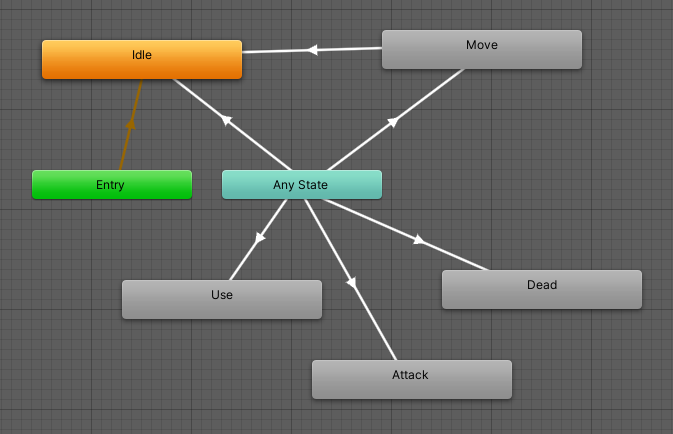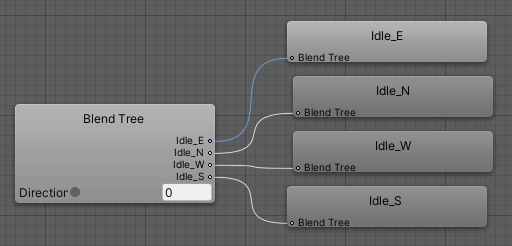In this tutorial we’ll set up our player and spawn it in the scene.
While the player group will have 2 members, we’ll only set up one for now – the fighter. The goal of this tutorial is to be able to run around with our player.
We’ll set up:
- animations
- the player (combatant)
- town scene (spawn, camera borders)
- start game schematic
Let’s get to it!
Animation Types #
First, we’ll set up a new animation type.
Animation types are used to play animations without having to worry what that animation actually is. E.g. an Attack animation type can play different animations based on what combatant plays it, or what weapon the combatant has equipped. You can learn more about animations in this documentation.
A new project already comes with multiple default animation types, so we only need to add one more for our use (though we don’t use most of the default ones).
Navigate to Base/Control > Animation Types and add new type.
13: Use #
This’ll be used to play an animation when using an item or ability.
- Name
Set to Use.
Animations #
We’ll already set up the animations for all combatants – the player combatants both use the same setup, while the enemies of this tutorial series are simply sprites without any animations (and if a combatant doesn’t use an animation, it just doesn’t play it). We’re using sprites (2D) as our combatants, i.e. our animations have to be set up using Mecanim (the legacy animation system doesn’t support sprite animations).
Let’s take a look at the animator controller, you can find it in Assets/Tutorial Assets/Animations/, the Combatant Controller is the basis for all combatants (they use animator override controllers to replace animations).
Idle, Move and Attack are blend trees, looking like this:
Since we’re dealing with 2D, we need different animations for different directions, this is handled by the blend trees, which use the combatant’s rotation interpreted into a 4-directional value (0-3), which is forwarded through our animation setup (see below).
Additionally, the Use, Attack and Dead animations are played by setting Bool parameters, i.e. they’ll play until we stop the animation (which switches the parameters off) – this lets us control the duration of these animations in our schematics, which will play and stop them as needed.
The animator controller uses the following parameters:
- Speed
The movement speed, forwarded from our animation setup.
Controls if idle or movement animations are used.
This is a Float parameter. - Direction
The direction the combatant is facing, forwarded from our animation setup.
Controls which direction animation is used.
This is a Float parameter. - Attack, Use and Dead
Play the according animations while toggled on.
These are Bool parameters.
This is just one possible setup for handling 2D animations, Mecanim and ORK are flexible and can support many different combinations and setups – ultimately, this’ll depend on what your game needs and how your combatants are moved.
Alright, let’s handle the setup in ORK. Navigate to Base/Control > Animations and change the Default animation setup.
Mecanim Settings #
We’ll forward the horizontal speed and the rotation (i.e. the direction) to the animator controller.
- Set Horizontal Speed
Enable this setting. - Horizontal Parameter
Set to Speed. - Set Z Rotation
Enable this setting.
In 2D environments, the directional rotation is the Z-axis (for 3D it’s usually the Y-axis). - Rotation Type
Select Direction 4.
The rotation of the combatant (0 to 360, or -180 to 180) will be translated into 4 directions, 0 (east), 1 (north), 2 (west) or 3 (south). - Set Float Parameter
Enable this setting.
We’ll set a float parameter, since blend trees only work with them. - Paremeter Name
Set to Direction.
We’ll now add 4 animations for attack, use, death and revive.
Mecanim Animaton 0 #
Click on Add Mecanim Animation.
- Animation Type
Select Attack.
Adjust the already added Animation 0. Since we play the animation via parameters and don’t need their duration, we don’t really need to set up anything beside the play/stop parameters.
Click on Add Parameter (Play).
- Parameter Name
Set to Attack. - Parameter Type
Select Bool. - Bool Value
Enable this setting.
Click on Add Parameter (Stop).
- Parameter Name
Set to Attack. - Parameter Type
Select Bool. - Bool Value
Disable this setting.
Mecanim Animation 1 #
Copy Mecanim Animation 0.
- Animation Type
Select Use.
We need to change the parameter names for play and stop.
- Parameter Name (Play)
Set to Use. - Parameter Name (Stop)
Set to Use.
Mecanim Animation 2 #
Copy Mecanim Animation 1.
- Animation Type
Select Death.
We need to change the parameter names for play and stop.
- Parameter Name (Play)
Set to Dead. - Parameter Name (Stop)
Set to Dead.
Mecanim Animation 3 #
Copy Mecanim Animation 2.
- Animation Type
Select Revive.
The revive animation will simply disable the Dead parameter when played.
- Bool Value (Play)
Disable this setting.
Remove the stop parameter change (Set Parameter (Stop) 0).
That’s it for the animations.
Combatants General Settings #
Next, we’ll handle some general settings for all our combatants. You can learn more about combatants in this documentation.
Navigate to Combatants > Combatants > General Settings.
Base Settings #
We’ll set up using Object Variables on our combatants. They’re variables that are bound to a combatant/game object.
We’ll later use them to show or hide an equipped weapon while attacking.
Object Variable Settings #
- Use Object Variables
Enable this setting. - Local Variables
Enable this setting.
This’ll make the variables unique for each instance of a combatant.
Otherwise, all combatants sharing the same Object ID will also share the same variables and their values.
Animations & Movement #
We’ll set up Mecanim as the default animation system and use the animations we just set up.
Additionally, we’ll set up the Default Movement Component for 2D movement.
Default Animation System #
- System Type
Select Mecanim.
Default Animations #
Click on Add Animations.
- Animations
Select Default.
Default Movement Component #
We’ll use the Default movement component – it’s a very simple component, in 3D it’ll move using a Character Controller, in 2D a Rigidbody 2D component (or rather, it uses the one it finds).
- Component Type
Select Default. - Add Component
Enable this setting.
The movement component is automatically added if it isn’t found.
In that case, it’ll use the setup provided here. - Face Target
Enable this setting.
The combatant will rotate into the direction it moves (in 2D on the Z-axis). - Smooth
Enable this setting.
This’ll make the movement a bit smoother. - Speed Smoothing
Set to 10.
Starting movement will not be immediately move at full speed and take a bit to reach full speed. - Rotation Damping
Set to 0.
We don’t want to smooth rotations, as it’s not needed for our 4-directional 2D animation setup.
Sound Settings #
We’ll make use of the sound types we’ve set up and assign default audio clips to them for all our combatants. The individual combatants can replace them with their own setup if you want.
You can also assign multiple audio clips to a sound type – one of the added clips will be played randomly.
The audio clips can be found in Assets/Tutorial Assets/NinjaAdventure/Sounds/Game/.
Click on Add Sound.
- Sound Type
Select Attack. - Audio Clip
Select the Sword2 audio clip.
Click on Add Sound again.
- Sound Type
Select Hit. - Audio Clip
Select the Hit audio clip.
Click on Add Sound again.
- Sound Type
Select Death. - Audio Clip
Select the Spirit audio clip.
Fighter Combatant #
For now, we’ll just change the name and set up a prefab, we don’t need any status setup (other than the automatic default setup), since we don’t fight in battles yet and only want to run around.
Navigate to Combatants > Combatants and select the Default combatant.
Content Information #
- Name
Set to: Fighter
Base Settings > Prefab Settings #
- Prefab
Select the Knight prefab.
You can find it in Assets/Tutorial Assets/NinjaAdventure/Actor/Characters/Knight/. - Update Mode
Select Fixed Update.
Our combatants are moved by Rigidbody2D components, i.e. the update mode (which determines when things like the move speed or movement direction are calculated) has to be set to update in the physics frame.
Otherwise you’ll experience strange jumps in speed, as it’s 0 in one frame and a high value in another, since the physics frame (FixedUpdate) and the regular frame (Update) are not in sync.
Save Changes #
That’s it for the setup in the editor for now.
Don’t forget to save your changes by clicking on Save Settings at the bottom of the editor.
Scene Setup #
Open the Town scene (found in Assets/Scenes/).
We’ll add an ORK Game Starter, a Spawn Point and Camera Borders.
Add Game Starter #
First, we’ll add a game starter to the scene and set it up for quick game testing. We’ll go with the ORK Game Starter variant.
Game starters are used to initialize your project, without it, you can’t access any functionality without causing errors. You can learn more about game starters in this documentation.
You can either use the scene hierarchy context menu or the scene wizard (e.g. via CTRL + ALT + W, or using the Unity menu: Window > Gaming Is Love > Makinom Scene Wizard).
I’ll use the context menu: ORK Framework > ORK Game Starter
The added game starter should already have your Project asset set up. Change the following setting in the ORK Game Starter component’s inspector.
- Start Game
Enable this setting.
This will immediately start a new game after initializing ORK.
It doesn’t really matter where you place the game starter, but it’s best to have them somewhere outside your actual level architecture to not get in the way.
Add Spawn Point #
Next, we’ll add a spawn point – we’ll spawn on the left side of town, directly by the exit.
Like the game starter, you can add a spawn point via the context menu or the scene wizard. The scene wizard has searchable popups for adding game objects or components, which can get very convenient when having to set up multiple things.
I’ll use the context menu: Makinom > Spawn Point
The spawn point will be placed directly on the ground (or whatever else is hit by the raycast into the scene) at the screen’s center – and it automatically has the next free Spawn ID assigned. Spawn IDs are used to identify a spawn point, so when we (soon) spawn our player using a schematic, that’s the spawn ID we’ll use.
Since there wasn’t a spawn point in the scene before, we’ll have the spawn ID 0 assigned.
Transform #
Change the position of the spawn point in the inspector.
- Position
Set to X=-18, Y=-1, Z=0.
Spawn Point #
- Use Rotation
Enable Z.
We’ll use the Z-axis rotation when spawning the player on this spawn point.
Add Camera Borders #
If you look at the scene hierarchy, you’ll see 2 game objects for our camera borders:
- Camera Border Left
- Camera Border Right
Those two already have a Box Collider 2D set up to cover their parts of the scene – when the player moves between them, the camera will switch over.
All we need to do is add a Camera Border component to each of them using the component menu. The component offers a few settings, but we don’t need any of them for our setup.
That’s it for the scene, save your changes.
Start Schematic #
A schematic is a reusable, node-based blueprint for what you want to do. It consists of connected nodes that work similar to a flow chart – each node performs a task and decides the next node that’ll be executed. You can learn more about schematics in this Makinom documentation.
You’ll make frequent use of schematics when creating your games, e.g. to talk to an NPC, animate an action in battle or, as in this case, set up what happens at the start of a new game. We’ll cover different setups as part of this tutorial series.
Open the Makinom editor again and navigate to Schematics – it’s time to set up a simple schematic we’ll use when starting our game.
We’ll join the Fighter to the player group and spawn at the spawn point (spawn ID 0).
Join Group #
Add Node > Group > Group > Join Group
First, we’ll add Fighter to the player group. This will automatically join a combatant to the group’s battle group as well, unless no free slot is available.
- Group Origin
Select Active Player Group.
This’ll join the combatant to the currently active player group. - Combatant
Select Fighter.
Spawn ORK Player #
Add Node > Game > Player > Spawn ORK Player
Now, we’ll spawn the player in the scene.
- Spawn At
Select Spawn Point. - Spawn Point ID
Set to 0.
And that’s it for the schematic. Click on Save Schematic to save it, e.g. as StartGame.
I usually save all my schematics in Assets/Schematics/ and sub folders of it.
Start Menu #
We don’t use the start menu yet (we just hit play in the Town scene), but we’ll need to set up our start schematic.
Navigate to UI > Start Menu and change the following settings.
New Game Settings #
- Start Schematic
Select the StartGame schematic.
Save Changes #
And that’s it – we’re ready to take our player for a test walk!
Don’t forget to save your changes by clicking on Save Settings at the bottom of the editor.
Testing #
Alright – let’s take a walk. With the Town scene still open, hit play.
Great, we spawn, can walk around and the camera border is doing it’s job … but the player’s sprite currently rotates into the movement direction … let’s fix that!
Combatant Prefab Setup #
All our (player) combatant prefabs are variants of a base prefab, so we only need to make changes to the base prefab.
Open the CombatantBase prefab for editing, you can find it in Assets/Tutorial Assets/Prefabs/Combatants/. The structure is like this:
The Mount and it’s child objects will rotate with the root (CombatantBase) into the direction the combatant moves.
However, we don’t want this for the Sprite, which displays the combatant’s sprite. To prevent this, we’ll add a Face Camera component to it.
Add Face Camera Component #
Add a Face Camera component to the CombatantBase > Sprite child object using the component menu.
- Makinom Camera
Enable this setting.
This’ll face the camera that’s found by Makinom in the scene, which usually is the game’s main camera.
And that’s it for the prefab – save the changes.
Testing #
Hit play in the Town scene again.
That looks better.
Next, we’ll set up the game’s music and connect our scenes.













